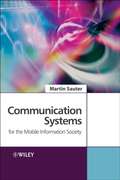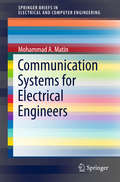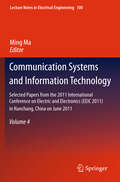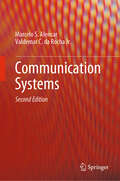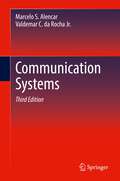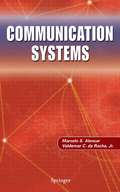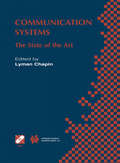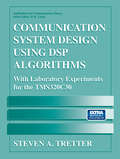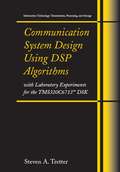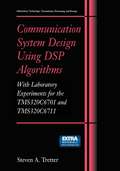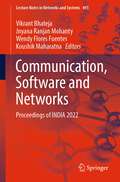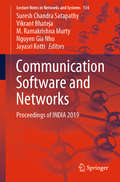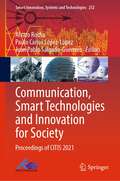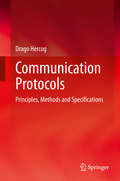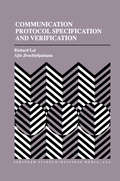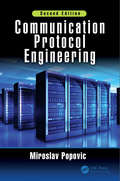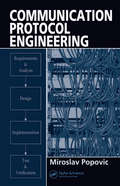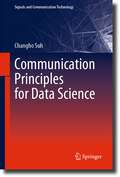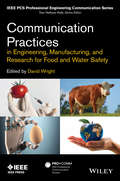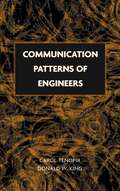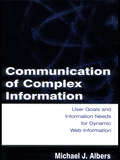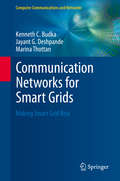- Table View
- List View
Communication Systems for the Mobile Information Society
by Martin SauterMany wireless systems like GSM, GPRS, UMTS, Bluetooth, WLAN or WiMAX offer possibilities to keep people connected while on the move. In this flood of technology and claims that one single resource will serve all our needs, this book seeks to enable readers to examine and understand each technology, and how to utilise several different systems for the best results. Communication Systems for the Mobile Information Society not only contains a technical description of the different wireless systems available today, but also explains the thoughts that are behind the different mechanisms and implementations; not only the 'how' but also the 'why' is in focus. Thus the advantages and also limitations of each technology become apparent. Provides readers with a solid introduction to major global wireless standards and compares the different wireless technologies and their applications Describes the different systems based on the standards, their practical implementation and the design assumptions that were made The performance and capacity of each system in practice is analyzed and explained, accompanied with practical tips on how to discover the functionality of different networks by the readers themselves Questions at the end of each chapter and answers on the accompanying website make this book ideal for self study or as course material Illustrated with many realistic examples of how mobile people can stay in touch with other people, the Internet and their corporate intranet This book is an essential resource for telecommunication engineers, professionals and computer science and electrical engineering students who want to get a thorough end-to-end understanding of the different technical concepts of the systems on the market today.
Communication Systems for Electrical Engineers (SpringerBriefs in Electrical and Computer Engineering)
by Mohammad A. MatinThis book is written as a very concise introduction for students taking a first course in communication systems. It provides the reader with fundamentals of digital communication systems and disseminates the essentials needed for the understanding of wire and wireless communication systems for Electrical Engineers. It covers important topics right from the beginning of the subject which communication engineers must understand. Example problems in each chapter will help them in understanding the materials well. The study of data networking will include multiple access, reliable packet transmission, routing and protocols of the internet. The concepts taught in class will be discussed in the context of aerospace communication systems: aircraft communications, satellite communications. The book includes example problems in each chapter to help the reader in understanding the materials well.
Communication Systems and Information Technology: Selected Papers from the 2011 International Conference on Electric and Electronics (EEIC 2011) in Nanchang, China on June 20-22, 2011, Volume 4 (Lecture Notes in Electrical Engineering #100)
by Ming MaThis volume includes extended and revised versions of a set of selected papers from the International Conference on Electric and Electronics (EEIC 2011) , held on June 20-22 , 2011, which is jointly organized by Nanchang University, Springer, and IEEE IAS Nanchang Chapter. The objective of EEIC 2011 Volume 4 is to provide a major interdisciplinary forum for the presentation of new approaches from Communication Systems and Information Technology, to foster integration of the latest developments in scientific research. 137 related topic papers were selected into this volume. All the papers were reviewed by 2 program committee members and selected by the volume editor Prof. Ming Ma. We hope every participant can have a good opportunity to exchange their research ideas and results and to discuss the state of the art in the areas of the Communication Systems and Information Technology.
Communication Systems
by Marcelo S. Alencar Valdemar C. da Rocha Jr.Presents main concepts of mobile communication systems, both analog and digital Introduces concepts of probability, random variables and stochastic processes and their applications to the analysis of linear systems Includes five appendices covering Fourier series and transforms, GSM cellular systems and more
Communication Systems
by Marcelo S. Alencar Valdemar C. da Rocha Jr.Presents main concepts of mobile communication systems, both analog and digital Introduces concepts of probability, random variables and stochastic processes and their applications to the analysis of linear systems Includes five appendices covering Fourier series and transforms, GSM cellular systems and more
Communication Systems
by Marcelo S. Alencar Valdemar C. da RochaPresents main concepts of mobile communication systems, both analog and digital Introduces concepts of probability, random variables and stochastic processes and their applications to the analysis of linear systems Includes five appendices covering Fourier series and transforms, GSM cellular systems and more
Communication Systems: The State of the Art IFIP 17th World Computer Congress - TC6 Stream on Communication Systems: The State of the Art August 25–30, 2002, Montréal, Québec, Canada (IFIP Advances in Information and Communication Technology #92)
by Lyman ChapinCommunication Systems: The State of the Art captures the depth and breadth of the field of communication systems: -Architectures and Protocols for Distributed Systems; -Network and Internetwork Architectures; -Performance of Communication Systems; -Internet Applications Engineering; -Management of Networks and Distributed Systems; -Smart Networks; -Wireless Communications; -Communication Systems for Developing Countries; -Photonic Networking; -Communication Systems in Electronic Commerce. This volume's scope and authority present a rare opportunity for people in many different fields to gain a practical understanding of where the leading edge in communication systems lies today-and where it will be tomorrow.
Communication System Design Using DSP Algorithms: With Laboratory Experiments for the TMS320C30 (Applications of Communications Theory)
by Steven A. TretterDesigned for senior electrical engineering students, this textbook explores the theoretical concepts of digital signal processing and communication systems by presenting laboratory experiments using real-time DSP hardware. Each experiment begins with a presentation of the required theory and concludes with instructions for performing them. Engineering students gain experience in working with equipment commonly used in industry. This text features DSP-based algorithms for transmitter and receiver functions.
Communication System Design Using DSP Algorithms: With Laboratory Experiments for the TMS320C6713™ DSK (Information Technology: Transmission, Processing and Storage)
by Steven A. TretterDesigned for senior electrical engineering students, this textbook explores the theoretical concepts of digital signal processing and communication systems by presenting laboratory experiments using real-time DSP hardware. This new edition updates the experiments based on the TMS320C6713 (but can easily be adapted to other DSP boards). Each chapter begins with a presentation of the required theory and concludes with instructions for performing experiments to implement the theory. In the process of performing the experiments, students gain experience in working with software tools and equipment commonly used in industry.
Communication System Design Using DSP Algorithms: With Laboratory Experiments for the TMS320C6701 and TMS320C6711 (Information Technology: Transmission, Processing and Storage)
by Steven A. TretterDesigned for senior electrical engineering students, this textbook explores the theoretical concepts of digital signal processing and communication systems by presenting laboratory experiments using real-time DSP hardware. The experiments are designed for the Texas Instruments TMS320C6701 Evaluation Module or TMS320C6711 DSK but can easily be adapted to other DSP boards. Each chapter begins with a presentation of the required theory and concludes with instructions for performing experiments to implement the theory. In the process of performing the experiments, students gain experience in working with software tools and equipment commonly used in industry.
Communication, Software and Networks: Proceedings of INDIA 2022 (Lecture Notes in Networks and Systems #493)
by Vikrant Bhateja Jnyana Ranjan Mohanty Wendy Flores Fuentes Koushik MaharatnaThis book highlights a collection of high-quality peer-reviewed research papers presented at the 7th International Conference on Information System Design and Intelligent Applications (INDIA 2022), held at BVRIT Hyderabad College of Engineering for Women, Hyderabad, Telangana, India, from February 25–26, 2022. It covers a wide range of topics in computer science and information technology, from wireless networks, social networks, wireless sensor networks, information and network security, to web security, Internet of Things, bioinformatics, geoinformatics, and computer networks.
Communication Software and Networks: Proceedings of INDIA 2019 (Lecture Notes in Networks and Systems #134)
by Suresh Chandra Satapathy Vikrant Bhateja M. Ramakrishna Murty Nguyen Gia Nhu Jayasri KottiThis book highlights a collection of high-quality peer-reviewed research papers presented at the Sixth International Conference on Information System Design and Intelligent Applications (INDIA 2019), held at Lendi Institute of Engineering & Technology, Vizianagaram, Andhra Pradesh, India, from 1 to 2 November 2019. It covers a wide range of topics in computer science and information technology, from wireless networks, social networks, wireless sensor networks, information and network security, to web security, Internet of Things, bioinformatics, geoinformatics and computer networks.
Communication, Smart Technologies and Innovation for Society: Proceedings of CITIS 2021 (Smart Innovation, Systems and Technologies #252)
by Álvaro Rocha Paulo Carlos López-López Juan Pablo Salgado-GuerreroThis book gathers high-quality papers presented at International Conference on Science, Technology and Innovation for Society (CITIS 2021), held in Guayaquil, Ecuador, on May 26–28, 2021. This book will present the recent research trends in the fields of software engineering, big data analysis, cloud computing, data engineering, data management and data mining, machine learning, deep learning, artificial intelligence, smart systems, robotics and automation, mechatronic design, and industrial processes design.
Communication Protocols: Principles, Methods and Specifications
by Drago HercogThis book provides comprehensive coverage of the protocols of communication systems. The book is divided into four parts. Part I covers the basic concepts of system and protocol design and specification, overviews the models and languages for informal and formal specification of protocols, and describes the specification language SDL. In the second part, the basic notions and properties of communication protocols and protocol stacks are explained, including the treatment of the logical correctness and the performance of protocols. In the third part, many methods for message transfer, on which specific communication protocols are based, are explained and formally specified in the SDL language. The fourth part provides for short descriptions of some specific protocols, mainly used in IP networks, in order to acquaint a reader with the practical use of communication methods presented in the third part of the book. The book is relevant to researchers, academics, professionals and students in communications engineering.Provides comprehensive yet granular coverage of the protocols of communication systems Allows readers the ability to understand the formal specification of communication protocolsSpecifies communication methods and protocols in the specification language SDL, giving readers practical tools to venture on their own
Communication Protocol Specification and Verification (The Springer International Series in Engineering and Computer Science #464)
by Richard Lai Ajin JirachiefpattanaCommunication protocols are rules whereby meaningful communication can be exchanged between different communicating entities. In general, they are complex and difficult to design and implement. Specifications of communication protocols written in a natural language (e.g. English) can be unclear or ambiguous, and may be subject to different interpretations. As a result, independent implementations of the same protocol may be incompatible. In addition, the complexity of protocols make them very hard to analyze in an informal way. There is, therefore, a need for precise and unambiguous specification using some formal languages. Many protocol implementations used in the field have almost suffered from failures, such as deadlocks. When the conditions in which the protocols work correctly have been changed, there has been no general method available for determining how they will work under the new conditions. It is necessary for protocol designers to have techniques and tools to detect errors in the early phase of design, because the later in the process that a fault is discovered, the greater the cost of rectifying it. Protocol verification is a process of checking whether the interactions of protocol entities, according to the protocol specification, do indeed satisfy certain properties or conditions which may be either general (e.g., absence of deadlock) or specific to the particular protocol system directly derived from the specification. In the 80s, an ISO (International Organization for Standardization) working group began a programme of work to develop formal languages which were suitable for Open Systems Interconnection (OSI). This group called such languages Formal Description Techniques (FDTs). Some of the objectives of ISO in developing FDTs were: enabling unambiguous, clear and precise descriptions of OSI protocol standards to be written, and allowing such specifications to be verified for correctness. There are two FDTs standardized by ISO: LOTOS and Estelle. Communication Protocol Specification and Verification is written to address the two issues discussed above: the needs to specify a protocol using an FDT and to verify its correctness in order to uncover specification errors in the early stage of a protocol development process. The readership primarily consists of advanced undergraduate students, postgraduate students, communication software developers, telecommunication engineers, EDP managers, researchers and software engineers. It is intended as an advanced undergraduate or postgraduate textbook, and a reference for communication protocol professionals.
Communication Protocol Engineering, Second Edition
by Miroslav PopovicThe book aims to enable the reader to master the engineering of communication protocols, which are amply present nowadays in mobile phones, tablets, laptops, smart appliances, and service providers' datacenters and clouds. Readers will acquire the theoretical knowledge and practical skills to successfully design, implement, test, and verify their solutions. The key benefits of the new edition align with the latest standard for conformance testing, TTCN-3, along with updated chapters. It explains process algebra CSP and how to model, simulate, and automatically verify CSP models in PAT.
Communication Protocol Engineering
by Miroslav PopovicAs embedded systems become more and more complex, so does the challenge of enabling fast and efficient communication between the various subsystems that make up a modern embedded system. Facing this challenge from a practical standpoint, Communication Protocol Engineering outlines a hands-on methodology for developing effective communication protocols for large-scale systems.A Complete RoadmapThis book brings together the leading methods and techniques developed from state-of-the-art methodologies for protocol engineering, from specification and description methods to cleanroom engineering and agile methods. Popovic leads you from conceptualization of requirements to analysis, design, implementation, testing, and verification. He covers the four main design languages: specifications and description language (SDL); message sequence charts (MSCs); tree and tabular combined notation (TTCN); and unified modeling language (UML).Practical Tools for Real SkillsFully illustrated with more than 150 figures, this guide also serves as a finite state machine (FSM) library programmer's reference manual. The author demonstrates how to build an FSM library, explains the components of such a library, and applies the principles to FSM library-based examples.Nowhere else are the fundamental principles of communication protocols so clearly and effectively applied to real systems development than in Communication Protocol Engineering. No matter in what stage of the process you find yourself, this is the ideal tool to make your systems successful.
Communication Protocol Engineering
by Miroslav PopovicThe book aims to enable the reader to master the engineering of communication protocols, which are amply present nowadays in mobile phones, tablets, laptops, smart appliances, and service providers’ datacenters and clouds. Readers will acquire the theoretical knowledge and practical skills to successfully design, implement, test, and verify their solutions. The key benefits of the new edition align with the latest standard for conformance testing, TTCN-3, along with updated chapters. It explains process algebra CSP and how to model, simulate, and automatically verify CSP models in PAT.
Communication Principles for Data Science (Signals and Communication Technology)
by Changho SuhThis book introduces the basic principles underlying the design and analysis of the digital communication systems that have heralded the information revolution. One major goal of the book is to demonstrate the role of the digital communication principles in a wide variety of data science applications, including community detection, computational biology, speech recognition and machine learning. One defining feature of this book is to make an explicit connection between the communication principles and data science problems, as well as to succinctly deliver the “story” of how the communication principles play a role for trending data science applications. All the key “plots” involved in the story are coherently developed with the help of tightly coupled exercise problem sets, and the associated fundamentals are explored mostly from first principles. Another key feature is that it includes programming implementation of a variety of algorithms inspired by fundamentals, together with a brief tutorial of the used programming tools. The implementation is based on Python and TensorFlow. This book does not follow a traditional book-style organization, but is streamlined via a series of lecture notes that are intimately related, centered around coherent storylines and themes. It serves as a textbook mainly for a junior- or senior-level undergraduate course, yet is also suitable for a first-year graduate course. Readers benefit from having a good background in probability and random processes, and basic familiarity with Python. But the background can be supplemented by almost self-contained materials, as well as by numerous exercise problems intended for elaborating on non-trivial concepts. In addition, Part III for data science applications should provide motivation and insights to students and even professional scientists who are interested in the field.
Communication Practices in Engineering, Manufacturing, and Research for Food and Water Safety (IEEE PCS Professional Engineering Communication Series)
by Traci Nathans-KellyThis book demonstrates some of the ways in which communication and developing technologies can improve global food and water safety by providing a historical background on outbreaks and public resistance, as well as generating interest in youth and potential professionals in the field History of muckraking in the food industry Case study on groundwater regulation Interviews with members of the beef industry and livestock market owners
Communication Practices in Engineering, Manufacturing, and Research for Food and Water Safety (IEEE PCS Professional Engineering Communication Series)
by Traci Nathans-KellyThis book demonstrates some of the ways in which communication and developing technologies can improve global food and water safety by providing a historical background on outbreaks and public resistance, as well as generating interest in youth and potential professionals in the field History of muckraking in the food industry Case study on groundwater regulation Interviews with members of the beef industry and livestock market owners
Communication Patterns of Engineers
by Carol Tenopir Donald W. KingCommunication Patterns of Engineers brings together, summarizes, and analyzes the research on how engineers communicate, presenting benchmark data and identifying gaps in the existing research. Written by two renowned experts in this area, the text: Compares engineering communication patterns with those of science and medicine Offers information on improving engineering communication skills, including the use of communication tools to address engineering departments' concerns about the inadequacies of communication by engineers Provides strong conclusions to address what lessons engineering educators, librarians, and communication professionals can learn from the research presented
Communication of Complex Information: User Goals and Information Needs for Dynamic Web Information
by Michael J. AlbersThe amount of information available for any realistic complex situation is likely to overwhelm most users, as well as stymie any designer tasked with presenting the information. Providing large amounts of information in a coherent and usable format remains an unresolved problem. Choosing, structuring, formatting, and displaying information to allow easy access and to facilitate understanding are critical issues for effective design. To build an effective design that addresses complex information needs, one must look at research from psychology, sociology, human computer interaction, and technical communication, and develop a complete picture of the situation. This book develops a foundation for analysis and design of the approaches to providing complex information in real-world situations. Author Michael Albers takes the view that the content of the information system is the most important component. As such, this volume presents the analysis that needs to be done before the interface is designed and before content is created. It strives to provide clear understanding of how the user thinks and what the user needs, so interface operation, content, and presentation can maximize their respective potentials in communicating with a user. This volume is intended for technical communicators, human-computer interaction designers, and information designers. It will also be useful for system designers and researchers, and those studying adaptive hypertext and related topics.
Communication of Complex Information: User Goals and Information Needs for Dynamic Web Information
by Michael J. AlbersThe amount of information available for any realistic complex situation is likely to overwhelm most users, as well as stymie any designer tasked with presenting the information. Providing large amounts of information in a coherent and usable format remains an unresolved problem. Choosing, structuring, formatting, and displaying information to allow easy access and to facilitate understanding are critical issues for effective design. To build an effective design that addresses complex information needs, one must look at research from psychology, sociology, human computer interaction, and technical communication, and develop a complete picture of the situation. This book develops a foundation for analysis and design of the approaches to providing complex information in real-world situations. Author Michael Albers takes the view that the content of the information system is the most important component. As such, this volume presents the analysis that needs to be done before the interface is designed and before content is created. It strives to provide clear understanding of how the user thinks and what the user needs, so interface operation, content, and presentation can maximize their respective potentials in communicating with a user. This volume is intended for technical communicators, human-computer interaction designers, and information designers. It will also be useful for system designers and researchers, and those studying adaptive hypertext and related topics.
Communication Networks for Smart Grids: Making Smart Grid Real (Computer Communications and Networks)
by Kenneth C. Budka Jayant G. Deshpande Marina ThottanThis book presents an application-centric approach to the development of smart grid communication architecture. The coverage includes in-depth reviews of such cutting-edge applications as advanced metering infrastructure, distribution automation, demand response and synchrophasors. Features: examines a range of exciting utility applications made possible through smart grid evolution; describes the core-edge network architecture for smart grids, introducing the concept of WANs and FANs; explains how the network design paradigm for smart grids differs from that for more established data networks, and discusses network security in smart grids; provides an overview of communication network technologies for WANs and FANs, covering OPGW, PLC, and LTE and MPLS technology; investigates secure data-centric data management and data analytics for smart grids; discusses the transformation of a network from conventional modes of utility operation to an integrated network based on the smart grid architecture framework.
